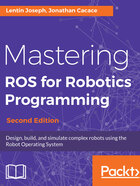
Moving robot joints using ROS controllers in Gazebo
In this section, we are going to discuss how to move each joint of the robot in Gazebo.
To move each joint, we need to assign an ROS controller. In particular, for each joint we need to attach a controller that is compatible with the hardware interface mentioned inside the transmission tags.
An ROS controller mainly consists of a feedback mechanism that can receive a set point and control the output using the feedback from the actuators.
The ROS controller interacts with the hardware using the hardware interface. The main function of the hardware interface is to act as a mediator between ROS controllers and the real or simulated hardware, allocating the resources to control it considering the data generated by the ROS controller.
In this robot, we have defined the position controllers, velocity controllers, effort controllers, and so on. The ROS controllers are provided by a set of packages called ros_control.
For a proper understanding of how to configure ROS controllers for the arm, we should understand its concepts. We will discuss more on the ros_control packages, different types of ROS controllers, and how an ROS controller interacts with the Gazebo simulation.